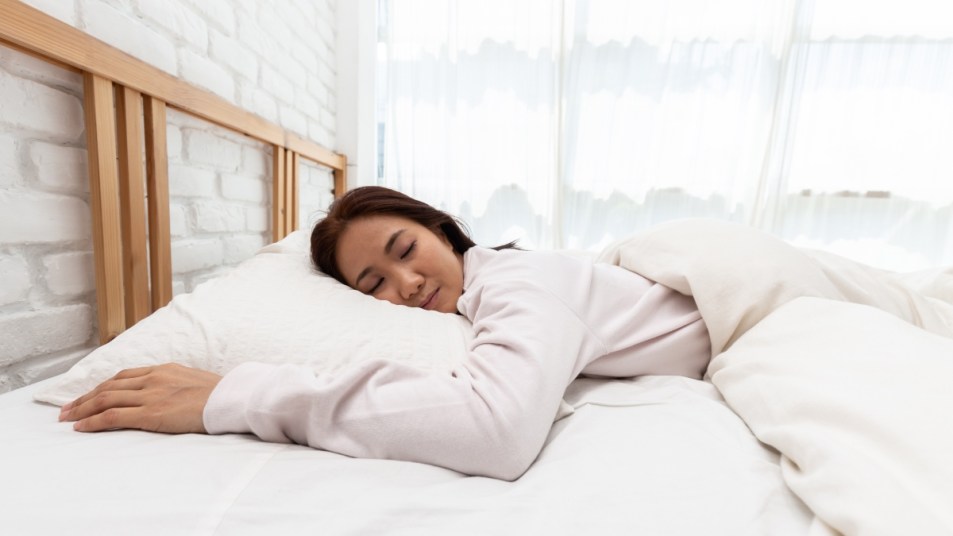How Much REM Sleep Do You Need? And How to Get More of Nature’s Best Medicine
Deeper sleep = happier you!

You know as well as we do that the amount and type of sleep you get every night can significantly affect your mood, energy level and comfort throughout the day. But isn’t it odd that sometimes you actually sleep fewer hours and yet feel more alert the next day? To understand that paradox, you need to understand the different types of sleep (like REM sleep) and the best way to improve your REM sleep. The good news is that you can take a few simple steps today to ensure you’re getting the deep sleep you deserve. Read on for a closer look at the stages of sleep and how you can improve your sleep pattern today.
What Is REM Sleep?
There are four different stages of sleep: one REM stage and three non-rapid eye movement sleep stages (also called NREM sleep or non-REM sleep). REM sleep is the period of the deep sleep process typically associated with vivid dreaming, but there’s more to it. REM stands for “rapid eye movement,” a period of rest during which your eyes move but don’t send visual messages to the brain. Even without those cues, brain activity is heightened during this period, which is why it’s the time of the night when we experience vivid dreams. (Dreaming may occur in other stages, but it is most intense, emotional, and realistic during this stage.)
RNEM sleep includes the period of drifting off, light sleep and deep sleep (also called slow-wave sleep). The first three stages take about 60 to 90 minutes, after which you will experience a period of REM sleep. The sleep cycle lasts for about one and a half to two hours and repeats several times throughout the night. Each REM cycle will last longer than the one before, and most adults will go through about three to five REM cycles per night for about 90 minutes of total REM sleep.
Why Is REM Sleep Important?
REM sleep is important at every stage of life. Babies typically spend about 50 percent of their sleep time in the REM cycle, whereas adults spend about 20 percent of the night in REM sleep. This is because REM sleep is important for cognition, energy and emotional regulation—that’s scientist-speak for sharper thinking and a happier mood on matter what life throws at you. REM sleep also plays an essential role in memory consolidation, or how your brain decides which memories and pieces of new information to hold onto. That’s not even mentioning brain development and emotional processing. Explains neurologist W. Chris Winter, MD, author of The Sleep Solution, “REM, which is when you dream, is a crucial restorative phase that needs to happen four or five times a night to bolster memory, mood regulation and pain tolerance.”
How Can You Get More REM Sleep?
Quality sleep is essential for our overall health and wellness, especially as we age. That’s why it’s important to get enough hours of sleep every night and to create the right conditions for maximum REM sleep. Here are a few simple steps we can take to ensure a good night’s sleep every night and reduce feelings of sleepiness in the morning.
Set a Sleep Schedule
If you’re struggling to fall asleep or stay asleep, a sleep schedule might be your best option. It can take some time to develop a schedule that meets your day-to-day needs and the natural function of your body, but it can be worth it. With a sleep schedule, you essentially set a time to sleep and wake up, and you don’t stray from it, even on the weekends. This helps to prepare your body for rest at night and helps you wake without hitting snooze in the morning.
Setting and sticking to regular sleep habits helps you get more consistent, restful sleep, including healthy REM sleep. It’s also been known to help with weight loss and to reduce your risk of chronic conditions like diabetes and heart disease. And you don’t need to change your bedtime to set a consistent sleep schedule — just stick to it.
Skip the Afternoon Coffee
Many of us couldn’t get through the day without a cup (or several!) of coffee. The problem? During the day, the body produces a chemical called adenosine, which makes us feel sleepier and sleepier the more it builds up. But caffeine blocks this chemical, preventing sleepiness from setting in.
This can cause big disruptions to our circadian rhythm, making it difficult to fall asleep even hours after consuming caffeine. And the longer it takes you to make it through the first stages of the sleep cycle, the longer it will take to get to the REM stage, and the fewer REM cycles you’ll experience through the night.
That’s why experts recommend avoiding caffeine in the 6 hours before bed. It’s also a good idea to avoid alcoholic beverages close to bedtime. Alcohol typically makes us sleepy and can serve as a sedative, meaning we fall asleep more quickly than we otherwise would. This disrupts the sleep cycle and affects how we enter and stay in REM sleep.
Consider Medications and Conditions
For many people, medications and medical conditions disrupt sleep. Medications like those prescribed for depression and anxiety have been shown to suppress REM sleep. If you notice a sudden change in energy and feelings of wakefulness, it’s best to consult your medical provider to take a look at your medications (Never stop taking medications without your doctor’s supervision.)
Another significant factor to consider when boosting REM sleep is menopause. During perimenopause and menopause, many women experience changes in their sleep cycle. This is partly due to menopausal symptoms, like changes in body temperature and night sweats, but it can also be due to the hormone fluctuations that occur during this period. Creating a peaceful environment, following a sleep schedule and getting regular activity earlier in the day can also be useful steps for women experiencing symptoms of menopause to improve the quality of their sleep.
Create a Peaceful Environment
No matter your stage of life, creating a peaceful environment is essential for getting enough REM sleep. That means you’ll want to make your bed as comfortable and fitting to your needs as possible, set the light in the room to a low and soft setting, and ensure that the temperature is cool and comfortable.
A cool sleeping environment and breathable bedding, like cotton or linen, are especially important for women experiencing symptoms of menopause, who may get warmer throughout the night. A noise machine can be a nice addition to the environment. It can also be helpful to designate the bed as a place for sleep, rest and intimacy. You’ll want to work or study elsewhere, so your brain doesn’t associate the bed with high-stress activities but instead thinks of it as a place to wind down in preparation for sleep.
Related: CBD Oil For Sleep: Top MDs Explain How It Works and When To Take It For Best Results
Develop a Nighttime Routine
Once you have set a sleep schedule and created a peaceful sleeping environment, you’ll want to develop a nighttime routine that helps you to feel relaxed and at ease. During this routine, consider peaceful practices like reading, listening to music or journaling before bed.
It’s also a good idea to limit your exposure to the blue light emitted by TVs, cell phones and other electronic devices before bed, as the light interferes with the sleep hormone melatonin, says clinical sleep psychologist Michael Breus, PhD. “When blue light hits melanopsin cells in the eye, they send a signal to the pineal gland that produces melatonin, telling it to turn off the melatonin faucet.” The result: sleep troubles and fatigue.
Try to Manage Stress
You can also take steps throughout the day to improve your sleep schedule at night, specifically through stress management. Stress, which is often associated with anxiety and overthinking, can make it difficult to fall asleep in the first place. This can affect your overall sleep schedule and your REM sleep stage. But stress can also permeate any dreams you might have during REM, which can cause restless REM sleep and premature waking. Managing the effects of stress in your day-to-day life can be useful for improving the quality of your REM sleep and getting the rest you deserve every night. (Click through to learn about the link between stress and another sleep sapper: sleep bruxism.)
Tip: Consider supplementing with magnesium at night. The mineral is known to help ease stress. Plus, “Magnesium turns out to be one of the best minerals to ease the transition into sleep no matter which chronotype you are,” says Breus. That’s because magnesium relaxes tense muscles and calms the central nervous system — effects that can help you drift off minutes sooner and reduce the risk of sleepless nights. A drink-mix powder to try: Natural Vitality Natural Calm
Better Sleep Tonight!
When you get proper rest, including REM sleep, you’ll feel rejuvenated, energized and engaged throughout the day. But don’t fret over numbers—8 hours of sleep isn’t necessary for all. “I’ve always been a 6.5-hour sleeper,” Breus says. “Whatever amount leaves you feeling refreshed should be your goal. Give yourself a break and enjoy the sleep you get!”
This content is not a substitute for professional medical advice or diagnosis. Always consult your physician before pursuing any treatment plan.













